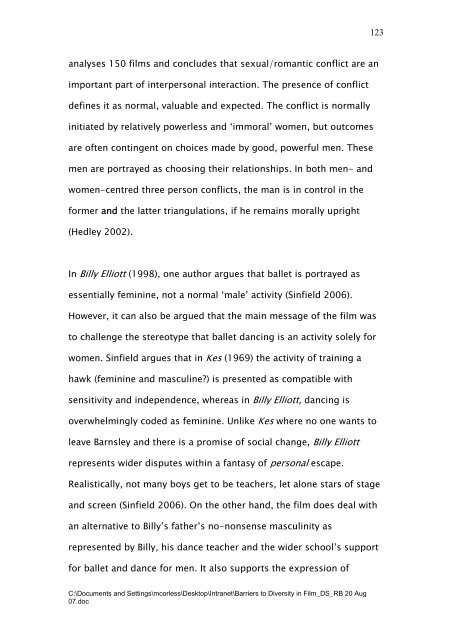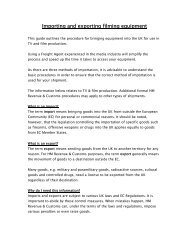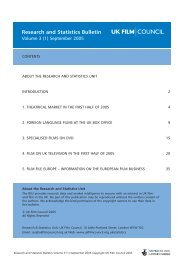Barriers to Diversity in Film – A Research Review – Aug 07
Barriers to Diversity in Film – A Research Review – Aug 07
Barriers to Diversity in Film – A Research Review – Aug 07
Create successful ePaper yourself
Turn your PDF publications into a flip-book with our unique Google optimized e-Paper software.
analyses 150 films and concludes that sexual/romantic conflict are an<br />
important part of <strong>in</strong>terpersonal <strong>in</strong>teraction. The presence of conflict<br />
def<strong>in</strong>es it as normal, valuable and expected. The conflict is normally<br />
<strong>in</strong>itiated by relatively powerless and ‘immoral’ women, but outcomes<br />
are often cont<strong>in</strong>gent on choices made by good, powerful men. These<br />
men are portrayed as choos<strong>in</strong>g their relationships. In both men- and<br />
women-centred three person conflicts, the man is <strong>in</strong> control <strong>in</strong> the<br />
former and the latter triangulations, if he rema<strong>in</strong>s morally upright<br />
(Hedley 2002).<br />
In Billy Elliott (1998), one author argues that ballet is portrayed as<br />
essentially fem<strong>in</strong><strong>in</strong>e, not a normal ‘male’ activity (S<strong>in</strong>field 2006).<br />
However, it can also be argued that the ma<strong>in</strong> message of the film was<br />
<strong>to</strong> challenge the stereotype that ballet danc<strong>in</strong>g is an activity solely for<br />
women. S<strong>in</strong>field argues that <strong>in</strong> Kes (1969) the activity of tra<strong>in</strong><strong>in</strong>g a<br />
hawk (fem<strong>in</strong><strong>in</strong>e and mascul<strong>in</strong>e?) is presented as compatible with<br />
sensitivity and <strong>in</strong>dependence, whereas <strong>in</strong> Billy Elliott, danc<strong>in</strong>g is<br />
overwhelm<strong>in</strong>gly coded as fem<strong>in</strong><strong>in</strong>e. Unlike Kes where no one wants <strong>to</strong><br />
leave Barnsley and there is a promise of social change, Billy Elliott<br />
represents wider disputes with<strong>in</strong> a fantasy of personal escape.<br />
Realistically, not many boys get <strong>to</strong> be teachers, let alone stars of stage<br />
and screen (S<strong>in</strong>field 2006). On the other hand, the film does deal with<br />
an alternative <strong>to</strong> Billy’s father’s no-nonsense mascul<strong>in</strong>ity as<br />
represented by Billy, his dance teacher and the wider school’s support<br />
for ballet and dance for men. It also supports the expression of<br />
C:\Documents and Sett<strong>in</strong>gs\mcorless\Desk<strong>to</strong>p\Intranet\<strong>Barriers</strong> <strong>to</strong> <strong>Diversity</strong> <strong>in</strong> <strong>Film</strong>_DS_RB 20 <strong>Aug</strong><br />
<strong>07</strong>.doc<br />
123
















